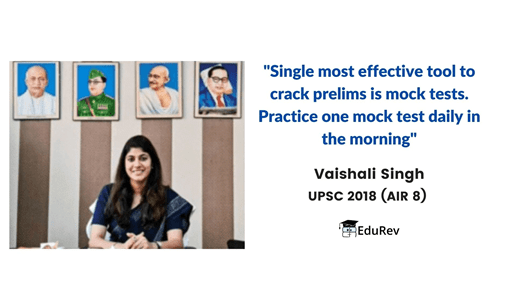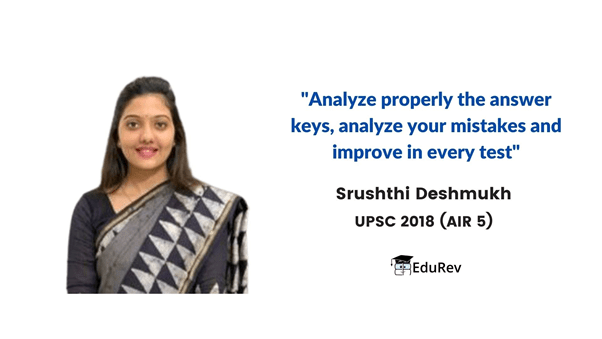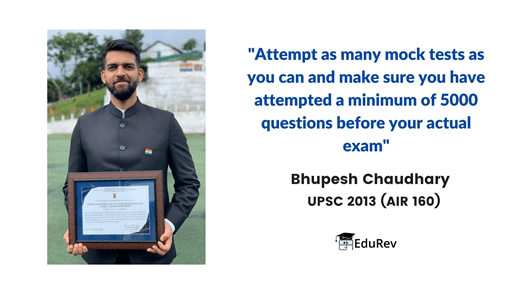How to attempt mock test series for UPSC Prelims? PDF Download
Mock tests are a valuable tool to understand what is missing in your preparation for UPSC. Mock Tests go a long way in helping aspirants acquire the skills of mark-fetching. Through Mock Tests, aspirants can introspect and analyze their level of preparation

Why Attempt Mock Tests?
- To Know ‘what to pick’ and ‘what to skip’: Mock Tests help you understand the dynamics of negative marking, present in the IAS prelims exam, so you can understand ‘what to pick’ and ‘what to skip’ and attempt the exam effectively.
- Helps to understand the question pattern: Mock test series are designed to help UPSC aspirants with their preparation. Through regular mock test practice, one can get familiar with the question pattern, syllabus, and difficulty level.
- Time Management & Problem Solving Speed: To crack the UPSC examination, one needs to learn how to manage the stipulated exam time to cover the maximum questions. With regular mock test practice, you can improve your speed and manage your time.
- Handling Unexpected Questions: Solving Mock Tests give you adequate practice in handling unexpected questions thrown at you in the exam. Mock Tests help you enhance your time management skills and pressure-handling ability.
What is the best approach to solving the full-length UPSC Mock Test?
A right approach to UPSC question paper or mock test can boost your marks, while a wrong or inefficient approach can cause you to lose valuable marks (also a year!).
- Solve the entire paper in rounds: You should solve the Mock Test or question paper in 4 rounds or stages which will be based on the number of answer choices you are able to eliminate. Don’t start solving questions at a stretch from 1 to 100, but rather use multiple rounds.
- First Round: Attempt 100% Sure Questions: In round 1, solve questions about which you are 100% sure. If you have eliminated 3 options out of 4, you are left with only one option, which is obviously the correct answer. Ideally, you should get at least 35 questions with 100% surety, if you have studied reasonably well.
- Second Round: Attempt 50% Sure Questions:
In round 2, solve questions about which you are 50% sure. If you have eliminated 2 options out of 4, you are left with only 2 options, out of which 1 would be the correct answer. If the probability of getting a question correct is more, we strongly suggest taking a risk and attempting that question - Third Round: Attempt Not So Sure Questions: In round 3, solve questions about which you are very little sure. Go for only those questions in which you have eliminated only 1 option and are confused in three options. There may be around 20 questions with 33% surety if you have studied reasonably well.
If the number of questions attempted after the 3rd round is less than 80, it’s not a bad strategy to take some additional risk and go for a 4rth round to answer questions. - Fourth Round: In round 4, go for only questions in which you have eliminated 0 option. There may be around 10 questions that will be very difficult to answer, however hard you study.
- When to start bubbling? Ideally, you should start bubbling at least by the 45th minute in the UPSC CSE Prelims
The above approach will help you improve your potential prelims marks in UPSC CSE. You should test and master this method in the Mock Tests to clear UPSC exam. Suppose you are scoring around 80 marks out of 200 in the mock test for Prelims, you can increase it to 130+ level, by following the above approach which is really useful in any MCQ-based exam.
How to attempt the questions in Mock Tests?
In UPSC Prelims: 2 marks are there for a correct answer and -0.66 for a wrong answer
and the Prelims Question Paper contains 100 Multiple Choice Questions (MCQs) each having four different answer choices.
To mark the answer correctly, you have two options:
- Either you should find the right answer directly with pre-existing knowledge OR
- Eliminate wrong answer choices to be left with the right answer choice.
You can follow the approach of intelligent elimination and master the second way of attempting the mock tests which is to eliminate wrong answer choices to be left with the right answer choice. There are many different techniques of intelligent elimination, However, given below are five techniques of intelligent elimination, practicing these techniques will boost your prelims score exponentially.
Technique 1: Do not go for unfamiliar answer choices, they will be false in most cases.
If you have diligently and honestly prepared for an exam, yet an answer choice seems to be completely foreign, then that choice is more than likely incorrect.Technique 2: Look for opposite answer choices. One of them can be the right answer.
To improve your odds of answering the question correctly is to look for answer choices that are complete opposites of one another. Often times one of the two answers is going to be correct.
for example in this question of UPSC CSE 2013:
Question: An increase in the Bank Rate generally indicates that the
(A) the market rate of interest is likely to fall
(B) Central Bank is no longer making loans to commercial banks
(C) Central Bank is following an easy money policy
(D) Central Bank is following a tight money policy
Answer: (D) Central Bank is following a tight money policy
Just narrow down your selection to answer choices that are complete opposites of one another. In the above case (C) and (D) contradicts each other.
So, the chance of any one of them to be the right answer is 50%.
Technique 3: Look for look-alike choices. One of them can be the answer.
If two answers look alike but are slightly different, one of the two choices is probably correct.
Question: What is the purpose of the ‘evolved Laser Interferometer Space Antenna (eLISA)’ project?
(A) To detect neutrinos
(B) To detect gravitational waves
(C) To detect the effectiveness of missile defence system
(D) To study the effect of solar flares on our communication systems
Answer: (B) To detect gravitational waves
Here, the look-alike choices are A, B, and C. Choice ‘C’ can be eliminated as it mentions about missiles, while the question is about ‘space’ antenna. We know that missiles are not generally connected with ‘space’. Now the choices are reduced to just 2: A or B. Neutrinos can be detected even from earth. The question is about Laser and Space. This eliminates option A. What is remaining is option B – which is the right answer. eLISA is used to detect gravitational waves.
Technique 4: The artificially complicated option is wrong in most cases
Don’t assume that the most complicated answer choice is correct. Often at least one or two of the possible choices will be unnecessarily complicated and are designed to serve as distracters for those who do not know the study material. In most cases, the unnecessarily complicated option is wrong.
Technique 5: Answer choices with ‘Always’ and ‘Never’ are usually wrong.
Words such as ‘always’ and ‘never’ reflect that an answer choice would apply regardless of the situation. Answers containing words like ‘always’ and ‘never’ are typically incorrect.
Question 3: The people of India agitated against the arrival of Simon Commission because
(A) Indians never wanted the review of the working of the Act of 1919
(B) Simon Commission recommended the abolition of Dyarchy (Diarchy) in the
provinces
(C) There was no Indian member in the Simon Commission
(D) The Simon Commission suggested the partition of the country
Answer: (C)There was no Indian member in the Simon Commission
Option ‘A’ has the word ‘never’. It is a too general statement, which can rarely be true. In fact, many Indians wanted a review of the working of the Act of 1919. Eliminate that option.
There are a lot of other Intelligent Elimination Techniques. Even you too can develop your own Intelligent Elimination Techniques. Every time you solve a UPSC CSE Question paper or Mock Test, try to notice some patterns and see the possibility of using a new elimination technique. You can go through the course: UPSC CSE Prelims 2022 Mock Test Series and attempt and practice as many mock tests as you want.
 |
Download the notes
How to attempt mock test series for UPSC Prelims?
|
Download as PDF |
How to effectively attempt the Mock Test Series?
You can follow the given approach compiled by talking to toppers and their mentors on How to attempt mock tests or can use it as a guideline to formulate your own approach and strategy for attempting the mock tests. The approach is divided into:
- Grasp the Concepts through Mock Tests & PYQs
- Master the Concepts through Mock Tests
- Analyze Mock Tests and Evaluate Yourself
- Revise and Stick to the Strategy
1. Grasp the Concepts through Mock Tests & PYQs
- Mock Tests after Basic Reading: The best time to start attempting Mock Tests is only when first reading your basic books both NCERTs and Standard books is finished.
“Topper Quote Image: If the basic reading is not done then there is no point of solving mocks as you won’t be able to understand the approach and mindset you need while solving mocks.” - Minal Karanwal AIR 35, CSE 2018 - Understand the approach and develop the mindset: After the basic reading of NCERTs and Standard books is completed, Through mock tests, develop a casual approach and try to grasp the concepts as well as revise the concepts you have already read.
- Previous Year Questions: To familiarise yourself with the UPSC Exam Pattern go through PYQs after the first reading of texts and go back again and read texts again with a new mentality and vision. This will help you to focus on what really matters.
You can find topic-wise PYQs of 25 years for prelims here.
You can also check the previous year's question papers of UPSC here. - NCERT Based Tests: You can also attempt NCERT based tests to quickly revise the concepts studied during the initial reading. Find the tests here.
2. Master the Concepts through Mock Tests
- Correct Way of Attempting the Mock Tests: Once you are done with the basics, you should start with attempting mock tests dedicatedly.
- Arrange a table and chair and prepare a real exam-like environment around you, with no disturbances or distractions.
- Stick to the time limit of the tests and complete the full tests in the given time only.
- Choose a proper time of giving mock tests like in the morning hours and attempt each mock test at that time only. - Subject Wise Mock Tests: Before proceeding to attempt full-length mock tests, start with Subject Wise Mock Tests. Focus equally on full syllabus tests and subject-wise or sectional mock tests to ace the exam.
You can find subject-wise mock tests for UPSC exam here. - Mock Tests for Current Affairs: Mock Tests for Current Affairs will help you test your knowledge on current events of national and international importance and also will make you learn quickly the most probable questions from the section.
Attempt Daily Tests for Current Affairs here. - Mock Tests For CSAT: CSAT is of qualifying nature but you have to pass it to be eligible for CSE Mains exam. Success in CSAT requires an efficient strategy. Attempting Mock Tests of this CSAT would be of great help to the aspirant.
Attempt Mock Tests for CSAT here. - Full-Length Mock Tests: Pick only one standard test series of UPSC Mock Tests and attempt it very diligently. Do not explore random online quizzes or venture into bait websites, it will unnecessarily waste your time.
You can go through EduRev’s Mock Test Series of UPSC CSE prelims from here.
3. Analyze Mock Tests and Evaluate Yourself

- Mock test analysis: Analyze the questions you attempted wrong and the questions you attempted right ASAP after each test. Figure out whether you were having complete knowledge of the questions you attempted right or not.
- Know your strengths and weakness: For the questions, you attempted wrong, understand why you committed the mistakes. Identify topics where you are going repeatedly wrong and work out ways to eliminate silly errors.
- Note down the tough questions: While you are analyzing the mock tests make sure, you note down and star mark those questions which you were having no idea about. You can write such questions in your notes and can revise them in the end or periodically.
You can attempt the mock tests available in the course here.
And can utilize EduRev’s feature of Mark for Review in the mock tests where you can mark the difficult question and can get view them back whenever needed. - Note Your Rank: Always try remaining in good or topmost ranks throughout but don’t get disappointed if you aren’t able to retain your rank. You can attempt the mock tests available in the course here. And can get to know your All India Rank after each mock test.
4. Revise and Stick to the Strategy
“Stick to final paper solving approach you develop right till end”- Akshat Jain AIR 02 UPSC CSE 2018
- Make your own Strategy: You can not attempt each and every question in UPSC exam. Try attempting 80-85 questions in each mock test and keep in mind that the number of wrong marked questions should not exceed more than 20 or 22. After 2-3, Mock Tests devise your own paper solving approach and stick to it right till the end.
- Revising Mocks: Revising all mock tests is not possible, but you can revise the star-marked questions that you noted while analyzing the mock tests. Do not forget to revise those tests entirely that you really think threw some new concepts at you and will be important for the UPSC exam.
FAQs on How to attempt mock test series for UPSC Prelims?
| 1. Why attempt mock tests? |  |
| 2. What is the best approach to solving the full-length UPSC Mock Test? |  |
| 3. How to attempt the questions in mock tests? |  |
| 4. How to effectively attempt the mock test series? |  |



























